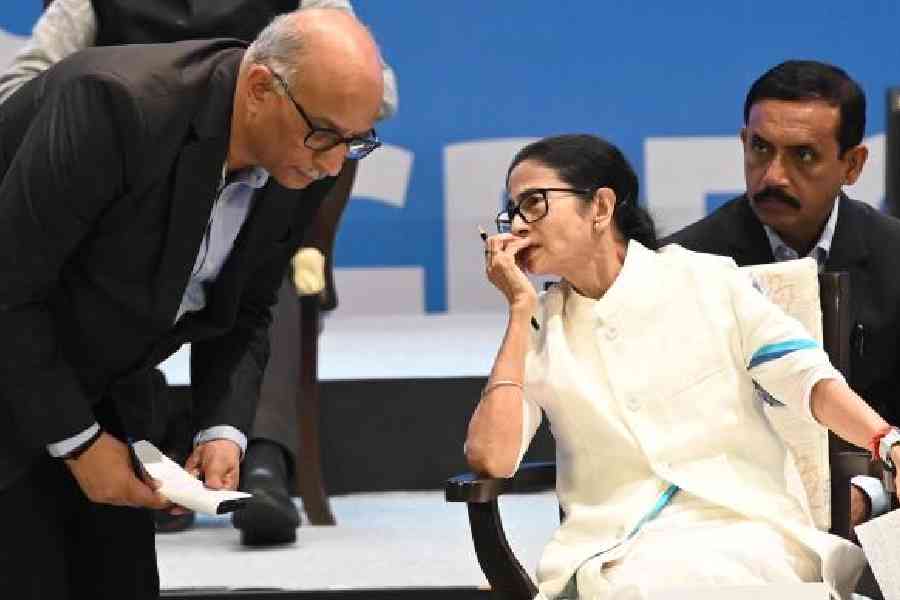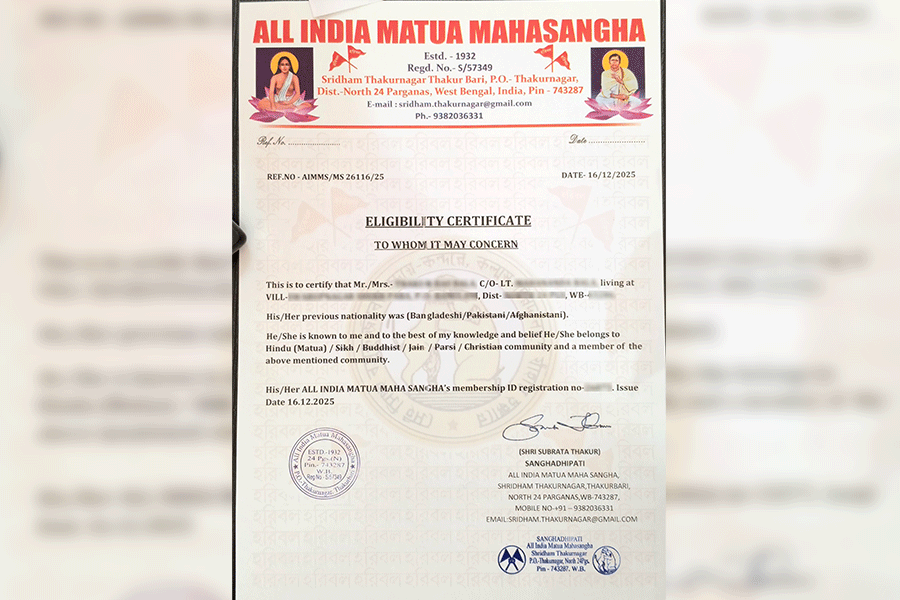 |
With a beatific smile of satisfaction on his face, Vivan Sundaram reaches across the wooden centre table to pick up the fruit of his hard labour. “Don’t even ask how long it’s taken me,” he laughs, while delicately pulling apart a cellophane cover to reveal a box set of two epic-size books, their pearly pages etched with a repository of priceless information about the life and works of one of India’s most iconic modern artists. No, not Sundaram — though he is one as well — but his aunt, Amrita Sher-Gil.
“And to think that writing books is not even my full-time profession,” he grins, as he pulls out the books from the box and carefully lays them side by side on the table. Amrita Sher-Gil: A self-portrait of letters and writings, says the title. Introduced, annotated and edited by the nephew.
It’s an hour before noon on Tuesday, and Sundaram is clearly pressed for time. And not without reason. The set — probably the most comprehensive anthology on Sher-Gil ever produced — is slated for release at the National Gallery of Modern Art in Delhi in less than six hours. Yet he settles into his chair in the library-cum-living room of his south Delhi home, cluttered with books and artworks, to talk at length about the project that took up precious years of his life to complete.
“It’s been so engaging and exhaustive that you can probably say this book is actually a part of my bigger art project,” says the 68-year-old. Coming from a person who’s celebrated across the world as one of India’s finest contemporary artists, that’s saying a lot.
Of course, the world also knows that Sundaram and Sher-Gil have less than six degrees of separation between them. Born in 1913 to the aristocrat and path-breaking photographer Umrao Singh Sher-Gil, a nobleman from Lahore, Amrita was the sister of pianist Indira Sundaram, Vivan’s mother. Clearly, lineage has a big role to play in Sundaram’s decision to portray his aunt in a light that few ever attempted to shed on the colourful life of the artist.
But Sundaram would want to go beyond the apparent reason to point out why his book scores over previous projects on Sher-Gil. “By reproducing the letters and other personal documents from her life, as well as providing a parallel text by way of annotations, this book attempts an honest portrait of the artist and her work,” he explains.
There are gaps in the text, he explains, largely because it’s pieced together from documents written at different stages of Sher-Gil’s life, which Sundaram painstakingly managed to glean out of the family troves. “But despite the jump-cuts and the fragmentary structure, the book is an intense reflection of the person and her artistic sensibilities,” he explains.
What’s even more interesting are the few asides from Amrita’s life that the volumes hold within their covers. For example, there’s this bill for her art material purchase, noted down to the annas. Or, for that matter, rare photographs of her relatives, and her many letters that straddle both her personal and professional worlds.
“Once in a while, these letters start out addressing a critic or scholar, and then move on to simple day-to-day observations,” says Sundaram, sharply turned out in a red jacket, his salt-and-pepper hair casually flipped aside, his lean figure poring over the pages of the book. “Like there’s one which starts out with an artistic discussion and then moves on to how she saw a cat in her room. Then there’s another one where she says that the future of art is in oil painting, although she admits that she hates the medium. But her words come true in later years, when modern Indian painters take to oil as their medium,” says Sundaram.
There are countless others too that reflect her state of mind in the mid-1930s, her musings on the Great Wars and the economic depression, and her ruminations on relocating to Gorakhpur from Paris, where she lived in her youth. All in all, a treasury of information for all Sher-Gil aficionados.
Over a steaming cup of tea, I ask Sundaram what his personal idea of Sher-Gil might be, given that she had passed away two years before his birth in 1943, and that these documents were his only means of familiarising himself with his aunt. “Well, she comes across as an opinionated, precocious, driven young woman; a talented artist who was clearly in a hurry to become a professional in the true sense,” says Sundaram, staring into the distance.
Sher-Gil, says the nephew, was enterprising, travelled widely, and was so serious about her work that she actually lugged her canvases with her to have exhibitions in places which had never witnessed one. “She was cosmopolitan, progressive, and at the same time very tied to her family. All in all, a very interesting person.”
But even as he talks of her strong bonds with her family, it’s difficult to ignore how Sundaram himself has — for many years — played a dutiful chronicler by documenting the rich artistic heritage of his own family. Only a few years ago, he embarked on a project that dealt with the life and works of his grandfather Umrao Singh, who — as is now acknowledged by several noted art critics — was one of the pioneers of modern Indian photography. The project culminated in a spectacular photographic exhibition, curated by Sundaram himself, in 2007-2008.
But how and when did his fascination with Sher-Gil begin? Leaning back on his chair, Sundaram, the son of a civil servant who was India’s second chief election commissioner, goes back to his childhood days in Shimla to reminisce about his first brush with her works. “I grew up surrounded by her canvases. They formed a part of my natural surroundings,” says Sundaram.
His mother, however, was quite reticent about her sister, he recalls. “Occasionally, she would mention how some of Amrita’s works were languishing in neglect in government museums, but stopped short of saying anything more about her.” Besides, Sundaram was perhaps too young then to realise the enormity of his aunt’s contribution to Indian art.
It was only after graduating from Doon School and joining the art college in Baroda that Sundaram managed to place her in context for the first time. However, another hiatus soon followed as he moved to the UK on a fellowship and enrolled at the Slade School of Fine Art, London, for a higher degree. “Again, there were so many new things to discover there that I completely forgot about her for a while,” he laughs.
It was when he returned to India in the early 1970s and took up art as a full-time vocation that Sundaram’s association with Sher-Gil began on a more permanent footing. “I started by organising a retrospective of her works in Bombay,” he says. And that was also when her work began to have a direct influence on Sundaram’s own creative output, which he says continued for many more years to come.
“Finally, in the early 1990s, I decided to get working on a project that would aim at detailing Amrita’s life and works in detail, and strike a new relation between her and her viewers through its text.” Now, some 20 years later, the project, brought to life by publishers Tulika Books, has just come full circle.
But in a world where concepts are being revolutionised and paradigms shifted quicker than the turning of clock hands, how formidable, really, is Sher-Gil’s legacy? “Looking back, there was a time when an entire generation of artists worked in her direction,” explains Sundaram. He points to the colour scheme of a painting that adorns the cover of one of the volumes and says, “Raza, for example, took this palette for his work. And then, in the 1970s, Amrita had a direct influence on a large number of women artists. So yes, much of her strategies have been worked out by people in the past.”
But does that hold even today, I ask. Sundaram heaves a little sigh. “You see, the agendas in the art world have changed in recent times,” he says. “A lot of people today believe that the world began only when they started making art. It’s sad when people negate history and live in denial simply because they want to push their own art in some kind of a capsule.” And that’s not mentioning how the lure of big money has subverted a lot of ideas in artistic spheres.
“So in a way, there isn’t much connection with history these days,” says Sundaram. It’s something he has learnt through his own long career in the arts. From redefining the use of media to planting the seeds of radical socio-political thoughts in his works, to hogging the limelight in top-notch galleries around the world, Sundaram has done it all. However, history has taught him to hang on to his humility even at the peak of his success. His dedication to documenting his family's legacy is perhaps one way of the artist paying his dues.
“But maybe things will change in the future,” says Sundaram. The optimism in the statement rings out loud and clear. And I can’t agree more. Someday, sooner than later.











